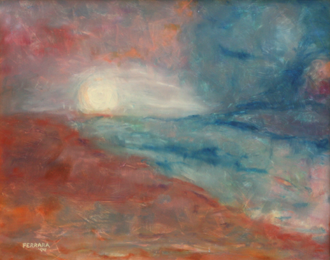How to “Own” an Artwork
Dear Reader,
Bill Hayes visited the Met with his two nieces and accomplished something remarkable. He taught them to find and fall in love with works of art. They would need to find pieces of art that would render them “helpless.” Next, he convinced them that those favorites could be theirs!
His essay made me remember art that I had fallen in love with and “taken” away with me. But, once we meet and fall in love, what can we do about having a sustained relationship with a work of art?
Here are some of my strategies for taking possession of a beloved artwork:
-
See the whole exhibit or gallery, then ask yourself which ones have stuck with you, then go back and find them. If it is a crowded exhibit, you may feel like a salmon swimming upstream, but it’s worth it. Take time. Examine paint strokes, the way light shows itself, the dance of shapes that make the entire piece feel balanced. Or unbalanced. How did Goya get those eyes to sparkle right at you? What is that under the surface along the bottom of the De Kooning? Could it be newspaper? What does it say?
-
Hayes cautions us to be choosy when searching for a piece of art to “own” and wait until we are “besotted.” Bravo! You cannot be moved by every artist’s every work, no matter how you have been taught to be impressed by a name or the term “masterpiece.” Listen to the small voice that beckons you from across the room. Have an intimate conversation with your new prospect.
-
Look for notecards or postcards and develop a collection of favorite images. Buy a museum catalog and/or a photo album. Clip postcards everywhere your imagination tells you. Take a break and sit with your newfound love. Look in a deliberate way or enjoy chance encounters as you go through your day.
Here are two stories: one about how I came to “own” several Impressionist and Post-Impressionist paintings and another about how I helped someone who was not the owner to take possession of “Sunrise, Sunset,” a 1999 painting of mine.
During two summers in the late 1980’s, John and I enrolled in the University of New Hampshire’s Summer Writing Program. These three-week blocks of time meant that we lived in on-campus student apartments. Bare-bones minimalism does not begin to describe the rooms: beige, mid-tone browns (couch, wooden tables, etc.) and more beige. At first, I reasoned that my head would be filled with writing and studying (true), and I might even get used to the bland interior (not true).
After a few days, I desperately needed to see some art in order to live and work. While we were loading our daisy-wheel printer, an idea struck me. I held the pile of paper, which came folded like an accordion and edged with rows of holes. Magically, three sheets rose from pile and told me they were Monet’s Water Lilies, the triptych from MoMA’s collection.
I said to John, “I have to try something!” Tearing off the section, I turned it horizontally and wrote the title in large letters across the pages. Then I grabbed tape and chose a place of honor in the living room.
The balloon had gone up, and soon every wall bloomed with colors and shapes (at least to my eyes). One beige wall held Matisse’s The Red Studio. Suddenly, moving through the apartment was a joy! A title would jar my visual memory just enough to produce the painting. Because of the monastic life we were leading, only the two of us knew about the treasures we were hoarding. Maybe that was a good thing.
My next story has to do with Emmy, a friend who lived nearby. She had become ill and soon made the decision to die at home, where I spent many hours visiting with her. A few years earlier, she had come to an exhibit and fallen in love with my painting, “Sunrise, Sunset.” It was never for sale because I had given it to John, who had become “besotted,” even as I was painting its final strokes.
Eventually, Emmy was housebound, then confined to her bed. After talking it over with John, I asked her if she wanted me to bring “Sunrise, Sunset” and make her its “owner.” She said yes.

